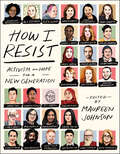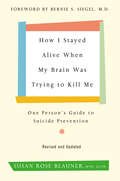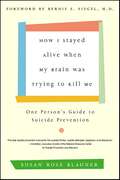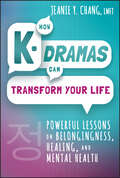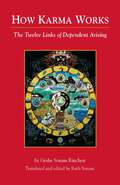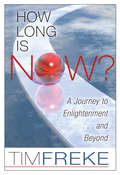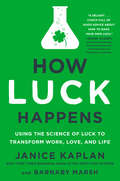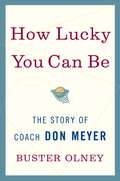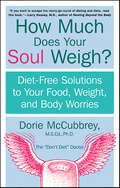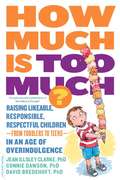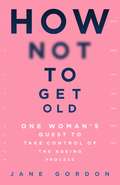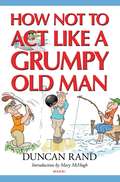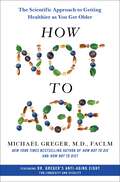- Table View
- List View
How I Overcame Social Anxiety (And How You Can Too!): An Introverts Guide to Recovering from Social Anxiety, Self-Doubt and Low Self-Esteem
by Tobias J. Atkins<p>Do you get nervous in public and don’t know why? Do you find it hard to relax and be yourself around people? Do you constantly worry what everyone thinks of you? Are you tired of always feeling inferior and ‘less than’ others? Wish you could turn off that critical voice inside your head? Perhaps you feel you were ‘born that way’ and things will never change? <p>This book documents my 15 year struggle with social anxiety; the contributing factors and the exact steps I took to find my healing. In these pages, you’ll discover: <p> <li>The real causes behind your social anxiety & shyness (it’s not what you think) <li>The exact steps I took to overcome social anxiety (and how you can too!) <li>How to stop fearing the opinions and judgments of others <li>How to let go of perfectionism and always putting yourself down <li>What I learned from spending over $35,000 on alternative therapies <li>Techniques to release anxiety and self-consciousness in minutes, not years</li> </p>
How I Quit Smoking: What’s True and What’s Not When It Comes to Quitting Smoking
by Toni García Arias“How I Quit Smoking” is the book that will help you quit smoking once and for all. This book was written by a smoker who, after almost twenty years smoking two packs of cigarettes a day, has quit smoking and not gone back. Thanks to his experience, in this book you will learn what’s true and what’s not when it comes to quitting smoking. Quitting isn’t easy, but this book and its author will be by your side throughout the entire process so you can be successful. Let’s do it!
How I Resist: Activism and Hope for a New Generation
by Maureen Johnson"The Ultimate Resistance Guidebook." — Bustle "This book will be a light in the darkness for some, and help guide them from despair."— BooklistAn all-star collection of essays about activism and hope, edited by bestselling YA author Maureen Johnson.Now, more than ever, young people are motivated to make a difference in a world they're bound to inherit. They're ready to stand up and be heard - but with much to shout about, where they do they begin? What can I do? How can I help? How I Resist is the response, and a way to start the conversation. To show readers that they are not helpless, and that anyone can be the change. A collection of essays, songs, illustrations, and interviews about activism and hope, How I Resist features an all-star group of contributors, including, John Paul Brammer, Libba Bray, Lauren Duca, Modern Family's Jesse Tyler Ferguson and his husband Justin Mikita, Alex Gino, Hebh Jamal, Malinda Lo, Dylan Marron, Hamilton star Javier Muñoz, Rosie O'Donnell, Junauda Petrus, Jodi Picoult, Jason Reynolds, Karuna Riazi, Maya Rupert, Dana Schwartz, Dan Sinker, Ali Stroker, Jonny Sun (aka @jonnysun), Sabaa Tahir, Shaina Taub, Daniel Watts, Jennifer Weiner, Jacqueline Woodson, and more, all edited and compiled by New York Times bestselling author Maureen Johnson. In How I Resist, readers will find hope and support through voices that are at turns personal, funny, irreverent, and instructive. Not just for a young adult audience, this incredibly impactful collection will appeal to readers of all ages who are feeling adrift and looking for guidance. How I Resist is the kind of book people will be discussing for years to come and a staple on bookshelves for generations.
How I Stayed Alive When My Brain Was Trying to Kill Me, Revised Edition: One Person's Guide to Suicide Prevention
by Susan Rose BlaunerNOW WITH A NEW CHAPTER AND AN UPDATED RESOURCES SECTIONSuicide has touched the lives of nearly half of all Americans, yet it is rarely talked about openly. In her highly acclaimed book, Susan Blauner—a survivor of multiple suicide attempts—offers guidance and hope for those contemplating ending their lives and for their loved ones.“Each word written with thoughtful intent; each story told with the deepest of honesty and humility, and in doing so Blauner puts forward a life-saving book."—Daniel J. Reidenberg, PsyD, Executive Director, Suicide Awareness Voices of Education (www.save.org)“I continued to romanticize my death by suicide: who would find me; what I’d look like. I spent hundreds of hours planning my funeral, imagining the remorse of my family and friends. I wrote good-bye letters, composed wills, and disrupted the lives of everyone close to me. Then reality hit.”—Susan Rose BlaunerThe statistics on suicide are staggering. The World Health Organization estimates that nearly 800,000 people die by suicide every year, which is one person every 40 seconds, and for each completed suicide there may be twenty or more attempts.In How I Stayed Alive When My Brain Was Trying to Kill Me, Susan Blauner is the perfect emissary for a message of hope and a program of action for these millions of people. A survivor of multiple suicide attempts, she explains the complex feelings and fantasies that surround suicidal thoughts. In a direct, nonjudgmental, and loving voice, she offers affirmations and suggestions for those experiencing life-ending thoughts, and for their friends and family. With an introduction by Bernie Siegel, M.D., this important, timely book has now been updated with a revised resources section, and a new chapter on the author’s experiences since the book’s initial publication.
How I Stayed Alive When My Brain Was Trying to Kill Me: One Person's Guide to Suicide Prevention
by Susan Rose BlaunerA woman shares her eighteen-year struggle with suicidal thoughts, explains the brain functions behind those thoughts, and offers tricks to overcome them.The statistics on suicide are staggering. According to the US Center for Disease Control and Prevention, in 1997 in the United States, more teenagers and young adults died from suicide than from cancer, heart disease, AIDS, birth defects, stroke, pneumonia, influenza, and chronic lung disease combined. It is also an international epidemic.Susan Blauner is the perfect emissary for a message of hope and a program of action for these millions of people. She’s been though it, and speaks and writes eloquently about feelings and fantasies surrounding suicide.“The best suicide prevention manual for the suicidal thinker, suicide attempter, layperson, or professional.” —Iris Bolton, founder of the National Resource Center for Suicide Prevention and Aftercare“How I Stayed Alive is like a Fodor’s guide that gets you from the depths of hell of depression to the paradise of a balanced life.” —Reese Butler, executive director and founder of the National Hopeline Network“With neither hollow platitudes nor medical doublespeak . . . an extreme valuable and much needed tool for suicidal thinkers and their loved ones.” —Publishers Weekly
How I Transformed my Life Thanks to Lockdown: 21 practices to change my vision, to higher my vibration and connect with the essential...myself
by Asma ElferkoussFeeling oppressed during lockdown, I decided to take life into my own hands and dedicate myself to change... I put into practice a series of rituals that helped me transform from a shy and victimised individual into a dynamic young woman able to make her dreams come true...
How Innovation Works: And Why It Flourishes in Freedom
by Matt RidleyBuilding on his national bestseller The Rational Optimist, Matt Ridley chronicles the history of innovation, and how we need to change our thinking on the subject.Innovation is the main event of the modern age, the reason we experience both dramatic improvements in our living standards and unsettling changes in our society. Forget short-term symptoms like Donald Trump and Brexit, it is innovation that will shape the twenty-first century. Yet innovation remains a mysterious process, poorly understood by policy makers and businessmen alike.Matt Ridley argues that we need to see innovation as an incremental, bottom-up, fortuitous process that happens as a direct result of the human habit of exchange, rather than an orderly, top-down process developing according to a plan. Innovation is crucially different from invention, because it is the turning of inventions into things of practical and affordable use to people. It speeds up in some sectors and slows down in others. It is always a collective, collaborative phenomenon, involving trial and error, not a matter of lonely genius. It happens mainly in just a few parts of the world at any one time. It still cannot be modeled properly by economists, but it can easily be discouraged by politicians. Far from there being too much innovation, we may be on the brink of an innovation famine.Ridley derives these and other lessons from the lively stories of scores of innovations, how they started and why they succeeded or failed. Some of the innovation stories he tells are about steam engines, jet engines, search engines, airships, coffee, potatoes, vaping, vaccines, cuisine, antibiotics, mosquito nets, turbines, propellers, fertilizer, zero, computers, dogs, farming, fire, genetic engineering, gene editing, container shipping, railways, cars, safety rules, wheeled suitcases, mobile phones, corrugated iron, powered flight, chlorinated water, toilets, vacuum cleaners, shale gas, the telegraph, radio, social media, block chain, the sharing economy, artificial intelligence, fake bomb detectors, phantom games consoles, fraudulent blood tests, hyperloop tubes, herbicides, copyright, and even life itself.
How It Feels to Find Yourself: Navigating Life's Changes with Purpose, Clarity, and Heart
by Meera Lee PatelFrom the author of Start Where You Are comes an illustrated guide for moving through life&’s biggest transitions with purpose and clarity. How It Feels to Find Yourself pairs vibrant color palettes with thoughtful observations and guidance for navigating the most important relationship in our lives: the one we have with ourselves. Through illustrated charts, honest essays, and insightful questions for deeper reflection, Meera Lee Patel encourages us to sharpen our internal compasses—so we can discover our purpose, let go of what we&’ve outgrown, and navigate challenging relationships with confidence. How It Feels to Find Yourself provides comfort for the difficult moments in life while serving as a source for deeper learning. It is a valuable gift for anyone who is facing uncertainty or entering a new chapter in life. Each page creates nostalgia for the places and experiences we&’ve already encountered, while shining a hopeful light toward where we are headed next.
How K-Dramas Can Transform Your Life: Powerful Lessons on Belongingness, Healing, and Mental Health
by Jeanie Y. ChangDiscover the power of how K-Dramas can improve your wellbeing and provide a sense of belonging Love K-Dramas and want more permission to binge watch them? In How K-Dramas Can Transform Your Life: Powerful Lessons on Belongingness, Healing, and Mental Health, Licensed Marriage and Family Therapist Jeanie Y. Chang explores what K-Dramas can teach us about our own well-being and how we can use the lessons they teach us to live better and more meaningful lives. She also touches upon the powerful interrelationship between K-dramas, mental health, and belongingness. Topics covered include: Using K-Dramas as a roadmap to life, showing you how to navigate speed bumps, roadblocks, twists, turns, and dead ends Building cross-cultural relationships that you otherwise may not have without being a K-Drama fan Processing grief from the loss of a loved one to a loss of anything—a job, your physical safety, a relationship, or something else Harnessing the idea of Jeong, which is innate in Korean society and refers to the emotional sentiment of affinity, affection, kinship, and connection which is the thread throughout Jeanie's community Working the author’s trademarked mental health framework, Cultural Confidence®, to build up your mental health, identity, mindfulness, and resilience For K-Drama fans and enthusiasts and anyone curious about the influence of pop culture, How K-Dramas Can Transform Your Life is an entertaining and educational must-read on how this enormously popular global phenomenon can help us become the best versions of ourselves.
How Karma Works: The Twelve Links of Dependent-Arising
by Geshe Sonam RinchenWe all want to find happiness and be free from suffering. Happiness comes from positive mental states and actions, and suffering from the opposite. The twelve-part process of dependent arising shows how actions underlain by ignorance propel us from one rebirth into another, keeping us trapped in suffering, and how through understanding reality correctly we can break this cycle. The four noble truths, the twelve links of dependent arising, and the two truths regarding conventional and ultimate reality, all interrelated, form the very core of the Buddha's teaching. The many different practices of sutra and tantra become meaningful and purposeful only when they are based on a good understanding of these fundamental and seminal principles. This oral teaching by Geshe Sonam Rinchen is based on the Rice Seedling Sutra and the twenty-sixth chapter of Nagarjuna's Treatise on the Middle Way.
How Life Works: Why Happy People are More Successful. How You Can Be Like Them!
by Andrew MatthewsA fun, whimisical primer to the New Thought movement.THE MYTH: Success makes you happy. THE FACT: Happiness makes you successful.It's not about who you know, or even what you know. It's about how good you feel, which, luckily for you, is entirely within your own power. Discover how to feel good, replace patterns of fear and failure with love and kindness, and create the life of abundance you've always dreamt of: * Doing work you love * Surrounded by people you love * And with the love of your life'In a Nutshell' features throughout provide useful reminders of the key valuable lessons in each chapter.How Life Works is illustrated with 90 of Andrew's trademark sketches. "My cartoons illustrate the message", says Andrew. "Cartoons also remind us not to take life too seriously."
How Long Is Now?: A Journey To Enlightenment... And Beyond
by Timothy FrekeIn this unique and exhilarating book, stand-up philos0pher Tim Freke shares his own amazing journey of awakening to the ecstasy of oneness and the bliss of big love. He offers profound insights and simple wake-up techniques to gently guide you ever more deeply into an experience he calls "lucid living," an ultra-awake state available to all, which transforms everyday life into a wonderful adventure full of meaning, miracles, and magic. As his spellbinding story unfolds, Tim clarifies a host of common misunderstandings about what it is to be "spiritual"; he offers wisdom about love, romance, and relationships; he presents a radical new understanding of death; and he passionately makes the case for our collective awakening. Full of warmth, laughter, tears, vitality, and style, How Long Is Now? is a timeless book to be savored and treasured.
How Luck Happens: Using the Science of Luck to Transform Work, Love, and Life
by Janice Kaplan Barnaby MarshNew York Times bestselling author Janice Kaplan examines the phenomenon of luck--and discovers the exciting ways you can grab opportunities and make luck for yourself every day. After spending a year researching and experiencing gratitude for The Gratitude Diaries, Janice Kaplan is back to tackle another big, mysterious influence in all our lives: luck. And this time she's joined on her journey by coauthor Dr. Barnaby Marsh, a renowned academic who guides her exploration. Together they uncover the unexpected, little-understood science behind what we call "luck," proving that many seemingly random events are actually under your--and everyone's--control. They examine the factors that made stars like Harrison Ford and Jonathan Groff so successful, and learn the real secrets that made Kate Spade and Warby Parker into global brands. Using original research, fascinating studies, and engaging interviews, Kaplan and Marsh reveal the simple techniques to create luck in love and marriage, business and career, and health, happiness, and family relationships. Their breakthrough insights prove that all of us--from CEOs to stay-at-home moms--can tip the scales of fortune in our favor. Through a mix of scientific research, conversations with famous and successful people--from academics like Dan Ariely and Leonard Mlodinow to actor Josh Groban--and powerful narrative, How Luck Happens uncovers a fascinating subject in accessible and entertaining style.
How Lucky You Can Be: The Story of Coach Don Meyer
by Buster OlneyIn September 2008, Northern State University men#x19;s basketball coach Don Meyer stood on the brink of immortality. He was about to surpass the legendary Bobby Knight to become the all-time NCAA wins leader in men#x19;s basketball. Then, on a two-lane road in South Dakota, everything changed in an instant. InHow Lucky You Can Be, acclaimed sports journalist Buster Olney tells the remarkable story of the successive tragedies that befell Coach Meyer but could not defeat him. Laid low by a horrific car accident that led to the amputation of his left leg below the knee, Coach Meyer had barely emerged from surgery when his doctors informed him that he also had terminal cancer. In the blink of an eye, this prototypical 24/7 workaholic coach-who arrived at the gym most mornings before 6 a. m. -found himself forced to reexamine his priorities at the age of sixty-three. A model of reserve, Coach Meyer had sacrificed much of his emotional life to his program. His wife, Carmen, felt disconnected because of his habitual reticence, while his three children-all now well into adulthood-had long had to compete with basketball for his attention. With sensitivity and skill, Olney shows how Coach Meyer mined his physical ordeal for the spiritual strength to transform his life. In the months that followed his accident and diagnosis, he reached out to family, friends, and former players in a way he had never been able to do before, making the most of this one last opportunity to tell those close to him how he felt about them-and in turn he received an outpouring of affirmation that confirmed how deeply he had affected others. Sustained throughout an often painful recovery by his love of basketball, he would return to the court once more-with a newfound appreciation for the game#x19;s place in his life. The inspirational story of a life renewed by unimaginable hardship,How Lucky You Can Beproves that it#x19;s never too late to start making changes-and reminds us that fortune can smile upon us even in our most trying hours. From the Hardcover edition.
How Memory Works--and How to Make It Work for You: G1196
by Robert MadiganDo you wish you could recall the names of people you just met? What if birthdays, important errands, and online passwords rarely slipped your mind? Psychologist Robert Madigan is an expert in the "memory arts"--practical, proven methods for improving the ability to retain and use information. Like taking the stairs instead of the elevator, it's important to exercise memory in simple ways every day. That's where this science-based guide can help. Dr. Madigan explains how memory works and presents innovative mnemonic devices and visualization techniques that will help you sharpen your mental skills; avoid embarrassing lapses; and remember faces, appointments, facts, numbers, lists, and much more. Reclaim your brain--this book shows how.
How Much Does Your Soul Weigh?: Diet-Free Solutions to Your Food, Weight, and Body Worries
by Dorie McCubbreyYou hold in your hands a life-changing weight control revelation -- a holistic approach to help you overcome all eating and weight problems from anorexia to obesity. This innovative book will shed light on your unsuccessful attempts at dieting and help you begin to heal from the inside out, once and for all!How many "miracle diets" have you tried? How many minutes and hours have you spent worrying about the numbers on the bathroom scale? How many times have you lost weight only to gain it back along with renewed disappointment and frustration? You've worried about how much your body weighs, but have you asked: How Much Does Your Soul Weigh?Dr. Doric McCubbrey, a weight-issues specialist whose practice boasts a 95 percent success rate, reveals that the weight of your soul may be preventing you from effecting the changes you want to see in your appearance and self-esteem. By starting Dr. Dorie's plan for "Intuitive Self-Care," you can begin to unburden your soul of all the "weighty attitudes" of the diet mentality -- rigid rules, negative self-talk, and unrealistic goals -- that lead to very real feelings of disappointment and hopelessness.With empathy and insight, Dr. Doric explores and explains the importance of a soulful attitude toward your eating, exercise, and weight. You'll discover:the "games" dieters play -- and why none of them worksthe four archetypal weight problems and how to overcome them for goodthe secrets of naturally thin people -- and how you can incorporate them into your lifea 30-day plan of therapeutic "recipes" designed especially to nourish your soulPacked with stories from Dr. Dorie's own 15-year struggle with overeating, anorexia, and bulimia, and the experiences of her clients, How Much Does Your Soul Weigh? shows you how to generate the happiness, health, balance, and confidence that will put your weight worries to rest for good!
How Much Is Too Much? [previously published as How Much Is Enough?]: Raising Likeable, Responsible, Respectful Children -- from Toddlers to Teens -- in an Age of Overindulgence
by Connie Dawson David Bredehoft Ph.D. Jean Illsley ClarkeA down-to-earth guide to regaining control of your kids and your family Overindulgence is not the badge of a bad parent. In fact, it comes directly from having a good and generous heart. But despite our good intentions, the abundance we heap on our kids often becomes more than they need or can handle. Family and parenting experts Jean Illsley Clarke, Connie Dawson, and David Bredehoft help you to understand: How damaging overindulgence can be for children When you are overindulging--and how to stop Which methods work best to establish firm rules and structure How to instill responsibility and independence in your kids What to do when family and friends are overindulging your kids What grandparents can do to help Based on new research gathered over the past ten years, How Much Is Too Much? gives you the insight and advice you need to put your children on track for a happy and successful life.
How Music Can Make You Better: (motivational Book, Neuroscience Book) (The HOW Series)
by Indre Viskontas PhDHow can certain songs carry us through a tough workout, comfort us after a breakup, or unite 50,000 diverse fans? In this fascinating field guide, neuroscientist and opera singer Indre Viskontas investigates what music is and how it can change us for the better—from deep in our neurons to across our entire society. Whether hip-hop fans, classically trained pianists, or vinyl collectors, readers will think about their favorite songs in a whole new way by the end of this book. This is a vibrant and smart gift for any audiophile.
How My Death Saved My Life: And Other Stories On My Journey To Wholeness
by Denise LinnHow My Death Saved My Life is the remarkable story of author Denise Linn. In this triumphant autobiography, Denise speaks with a compassionate yet fiery conviction, born of deep pain, as she describes overcoming the horror of an abusive childhood and the terror of being stricken down by an unknown gunman. From the mundane to the mystical, follow Denise’s inner and outer journeys as she grows up in various homes from abandoned army barracks, to the slums of Chicago, to an Ohio farming community. Travel with her as she is fired on by a plane in Yugoslavia, is tear gassed during antiwar riots, explores the sexual revolution in the ’60s, lives in a Buddhist monastery, and travels to native cultures to become one of the world’s most sought-after speakers and a best-selling author. Thousands of people worldwide have attended her lectures . . . and now, for the first time, they can read the story behind this internationally renowned woman.
How NOT to Get Published: Teach Yourself
by Claire GillmanThere are many brilliant books out there, which have not been published because theirauthor has not been able to successfully navigate the minefield that is finding a publisher. In many cases, authors make basic mistakes in their submissions, which ensure that they do not even get read by the correct person. Even if they do reach someone with decision-making power, they often fail to clearly explain the proposition of their book, or the target market.Claire Gilman is the perfect person to help you find a publisher for your manuscript. Shehas done it successfully, having had twenty of her own books published. She has spokento many commissioning editors and agents about what they look for (and look to avoid) in a submission. And she has worked as a literary consultant, helping all sorts of authors to improve their proposals. Now, she combines all this wisdom into one book, explaining clearly 50 common mistakes which authors make, and how you can avoid them and ensure that your work receives the attention and the publisher that it deserves.
How Not To Get Old: One Woman's Quest to Take Control of the Ageing Process
by Jane Gordon'A jolly quest to make the greying years more colourful' The TimesWhen journalist Jane Gordon was hospitalised and left immobile after a nasty car accident, dependent on others to feed her and help her to the bathroom, she suddenly had to confront what it might be like to one day be old and infirm. Determined to not only regain her strength but find ways to stay physically and mentally fit for as long as possible, Jane decided to road-test different self-help programmes designed to promote longevity. From ballroom dancing to brain training, learning a second language to silent meditation, joining the gym and improving her gut health, Jane seeks advice from top neuroscientists and medical professionals to assess the impact these courses have on her health, and whether they will stop her getting old before her time. Part self-help, part manifesto, How Not To Get Old is about future-proofing your physical and mental wellbeing and taking control of the ageing process, rather than wallowing in it. For what begins as a clever experiment in the art of stopping time becomes a joyous celebration of what we CAN do, not what we can't or shouldn't, and ultimately demonstrates how later life is still very much for living...
How Not to Act Like a Grumpy Old Man
by Mary Mchugh Duncan RandIs Your Age Getting You Down? Are you now grumpy because of it? If you're looking for ways to start thinking and acting young again, then this humorous, advice-filled book is for you. Included are tips of how you can live a happy, fulfilling, and exciting senior life. Discover ways to make each day better than the last while feeling better, looking better, and enjoying yourself more with hobbies, travel, continued education, second careers, and even marriage, while not overlooking the value family and friends, plus much more. So why be grumpy in your golden years when your life can still be productive, fun and fulfilling? How Not to Act Like a Grumpy Old Man will show you the way.
How Not to Act Old: 185 Ways to Pass for Phat, Sick, Dope, Awesome, or at Least Not Totally Lame
by Pamela Redmond SatranHow to be cool when you're afraid you've forgotten how . . . Sure, you can try to stay younger by exercising, coloring your hair, and wearing stylish clothes--but how do you respond when someone asks, "Do you Twitter?" How Not to Act Old gives you simple ways to come back from over the hill and to act as young as you look.Covering everything from old-people entertainment (cancel that dinner party!) to old-people communication (it's called a "voice mail," not a "message," and no one leaves or listens to them anyway), Pamela Redmond Satran decodes the behaviors, viewpoints, and cultural touchstones that separate you from the hip young person you wish you still were. This irreverent guide is essential for anyone who doesn't want to embarrass their kids--or themselves.
How Not to Act Old: 185 Ways to Pass for Phat, Sick, Dope, Awesome, or at Least Not Totally Lame
by Pamela Redmond SatranHow to be cool when you're afraid you've forgotten how . . . Sure, you can try to stay younger by exercising, coloring your hair, and wearing stylish clothes--but how do you respond when someone asks, "Do you Twitter?" How Not to Act Old gives you simple ways to come back from over the hill and to act as young as you look.Covering everything from old-people entertainment (cancel that dinner party!) to old-people communication (it's called a "voice mail," not a "message," and no one leaves or listens to them anyway), Pamela Redmond Satran decodes the behaviors, viewpoints, and cultural touchstones that separate you from the hip young person you wish you still were. This irreverent guide is essential for anyone who doesn't want to embarrass their kids--or themselves.
How Not to Age: The Scientific Approach to Getting Healthier as You Get Older
by Michael Greger M.D.Instant New York Times BestsellerUncover the evidence-based science to slowing the effects of aging, from the New York Times bestselling author of the How Not to Die series When Dr. Michael Greger, founder of NutritionFacts.org, dove into the top peer-reviewed anti-aging medical research, he realized that diet could regulate every one of the most promising strategies for combating the effects of aging. We don’t need Big Pharma to keep us feeling young—we already have the tools. In How Not to Age, the internationally renowned physician and nutritionist breaks down the science of aging and chronic illness and explains how to help avoid the diseases most commonly encountered in our journeys through life.Physicians have long treated aging as a malady, but getting older does not have to mean getting sicker. There are eleven pathways for aging in our bodies’ cells and we can disrupt each of them. Processes like autophagy, the upcycling of unusable junk, can be boosted with spermidine, a compound found in tempeh, mushrooms, and wheat germ. Senescent “zombie” cells that spew inflammation and are linked to many age-related diseases may be cleared in part with quercetin-rich foods like onions, apples, and kale. And we can combat effects of aging without breaking the bank. Why spend a small fortune on vitamin C and nicotinamide facial serums when you can make your own for up to 2,000 times cheaper?Inspired by the dietary and lifestyle patterns of centenarians and residents of “blue zone” regions where people live the longest, Dr. Greger presents simple, accessible, and evidence-based methods to preserve the body functions that keep you feeling youthful, both physically and mentally. Brimming with expertise and actionable takeaways, How Not to Age lays out practical strategies for achieving ultimate longevity.


